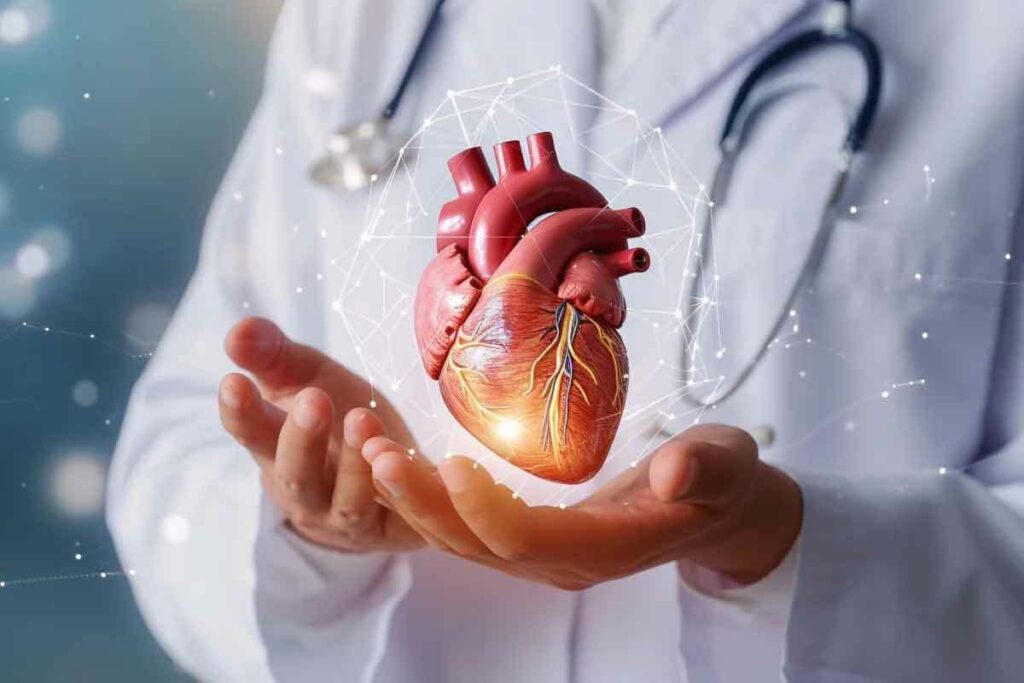
Coronary thrombosis is a serious condition where a blood clot forms in a coronary artery. This can lead to a heart attack. At Liv Hospital, we understand the importance of timely and expert care for this condition. It can quickly become life-threatening without proper treatment.
A heart attack happens when an artery that sends blood and oxygen to the heart is blocked. This blockage is often caused by a buildup of fats, cholesterol, and other substances. These can make arteries narrow, restricting blood flow. Understanding cardiac thrombosis and its effects on heart health is key to maintaining overall cardiovascular well-being.

A blood clot in a coronary artery is called a coronary thrombosis. It can seriously harm your heart health. This condition happens when a blood clot blocks or stops blood flow to the heart muscle.
Arterial thrombosis, including coronary thrombosis, is when a blood clot forms in an artery. This clot can block or stop blood flow to major organs like the heart or brain. Knowing how blood clots form helps us understand how coronary thrombosis affects the heart.
Blood clotting in the coronary arteries is a complex process. It involves many cellular and molecular components. It usually starts with damage to the artery’s inner lining, often because of atherosclerosis.
When the plaque ruptures, it exposes lipid-rich material to the bloodstream. This triggers platelet activation and the coagulation cascade. The clot can grow big enough to block blood flow through the artery, causing myocardial infarction or heart attack.
Coronary thrombosis is often mixed up with other heart conditions. But it’s unique because it involves a blood clot in a coronary artery. Unlike other conditions, like angina pectoris, coronary thrombosis is a real clot blocking blood flow.
| Condition | Description | Key Characteristics |
| Coronary Thrombosis | Formation of a blood clot in a coronary artery | A clot obstructs blood flow to the heart muscle |
| Angina Pectoris | Chest pain due to reduced blood flow to the heart | Typically triggered by exertion, relieved by rest |
| Myocardial Infarction | Damage to the heart muscle due to a lack of blood flow | Often caused by coronary thrombosis, it can be fatal |
It’s important to know the differences for accurate diagnosis and treatment. By understanding coronary thrombosis, healthcare providers can give better care. They can help restore blood flow and prevent more damage.

It’s key to grasp the effects of coronary thrombosis to fight it better. This condition causes a lot of sickness and leads to over 200,000 sudden heart deaths each year in the U.S. It’s a top reason for heart attacks, which can cause severe chest pain and is a big emergency.
Coronary thrombosis is common, affecting many people. It’s said that 7.2 million adults in the U.S. have coronary heart disease, which often comes from coronary thrombosis. The death rate from coronary thrombosis is high, with sudden heart deaths being a big part of it.
“Coronary thrombosis is a major cause of morbidity and mortality worldwide, necessitating a broad approach to prevention and treatment.” This condition’s impact isn’t just on the person; it also hits hard on healthcare systems and society.
The cost of coronary thrombosis is huge, with big expenses for emergency care, hospital stays, and ongoing care. In the U.S., heart disease costs over $100 billion each year. It also affects the lives of patients and their families, making their quality of life worse.
Looking into coronary thrombosis shows we need a wide range of solutions. This includes stopping it before it starts, finding it early, and treating it well. By understanding coronary thrombosis better, we can work on ways to lessen its impact and boost heart health.
Coronary arteries are key to bringing oxygen and nutrients to the heart muscle. This is what keeps the heart working right. The heart, being a muscle, needs blood all the time to keep pumping.
The coronary arteries start from the aorta, which comes out of the heart’s left ventricle. They then split into smaller paths that cover the heart’s surface. These paths give the heart muscle the oxygen and nutrients it needs. The left coronary artery and the right coronary artery each serve different parts of the heart.
The design of the coronary arteries is perfect for the heart’s needs. They have a detailed network of tiny vessels. This network helps deliver oxygen and nutrients efficiently.
Blood flow through the heart is carefully managed. The coronary arteries send blood to the heart muscle when it relaxes. This blood goes through tiny capillaries, where it picks up oxygen and nutrients.
After that, the blood gets picked up by the coronary veins. It then goes back to the right atrium through the coronary sinus. Knowing how the coronary artery function works is key. It helps us see how problems, like blockages, can harm the heart.
In short, the coronary arteries are vital for heart health. They ensure the heart gets the blood it needs. Any blockage, like a coronary thrombosis, can seriously affect the heart’s function.
It’s important to understand how coronary thrombosis affects the heart. This condition often starts with plaque rupture. This rupture leads to a blood clot that blocks a coronary artery.
Atherosclerosis plays a big role in coronary thrombosis. It damages the artery walls, making them more likely to form clots. Atherosclerotic plaques can become unstable and rupture, causing thrombosis.
The process involves:
Plaque rupture is a key event in coronary thrombosis. When a plaque ruptures, it releases material into the bloodstream. This starts the thrombosis cascade.
The thrombosis cascade can be summarized as follows:
Understanding these processes is key to grasping coronary thrombosis. It helps in developing effective treatments.
A blood clot in the coronary arteries, called coronary thrombosis, often causes heart attacks. This clot can cut down blood flow to the heart. This might lead to a heart attack.
Coronary thrombosis blocks blood flow to the heart muscle. This blockage damages the heart muscle because it lacks oxygen and nutrients. This damage is called ischemia.
If the blockage isn’t treated quickly, the heart muscle can be permanently harmed. This leads to a myocardial infarction.
The process starts with a burst of atherosclerotic plaque in the coronary artery. The burst exposes a lipid core to the blood. This triggers a blood clot. The clot can grow fast and block the artery, reducing blood flow to the heart muscle.
Heart attacks from coronary thrombosis are classified by ECG changes and biomarkers. These show heart muscle damage.
| Type of Heart Attack | ECG Changes | Biomarkers |
| STEMI | ST elevation | Elevated |
| NSTEMI | No ST elevation | Elevated |
| Unstable Angina | Variable | Normal |
Knowing the different heart attack types is key for doctors. It helps them choose the best treatment.
Coronary thrombosis can be caused by many risk factors. These can be divided into non-modifiable and modifiable factors. Knowing these factors is key to preventing and managing coronary thrombosis.
Non-modifiable risk factors are things we can’t change. These include:
Lifestyle choices can be changed to lower risk. These include:
Studies show that changing these lifestyle factors can greatly lower the risk of coronary thrombosis. For more on managing coronary thrombosis, check out this resource.
Some medical conditions also raise the risk of coronary thrombosis. These include:
| Medical Condition | Description | Impact on Coronary Thrombosis Risk |
| Hypertension | High blood pressure | Increases strain on blood vessels, potentially leading to damage and clot formation. |
| Diabetes Mellitus | High blood sugar levels | It can damage blood vessels and nerves, increasing the risk of coronary thrombosis. |
| Hyperlipidemia | High levels of fats in the blood | Contributes to the formation of plaques in arteries, increasing the risk of thrombosis. |
By understanding and managing these risk factors, you can lower your chance of getting coronary thrombosis. This involves making lifestyle changes, managing medical conditions, and sometimes using preventive medications.
The symptoms of acute coronary thrombus can differ. Yet, some signs are clear indicators. The main symptom is sudden chest pain and shortness of breath.
Symptoms of acute coronary syndrome include chest pain or discomfort. This pain feels like pressure or tightness. It can spread to the shoulders, arms, or jaw.
People may also feel nausea and shortness of breath. These are warning signs that need quick medical help.
Other signs include cold sweats and lightheadedness. If you have these symptoms, get emergency care right away.
Some groups, like diabetic patients or older adults, may show different symptoms. They might feel fatigue or confusion. This makes it harder to diagnose.
It’s important for healthcare providers to know these variations. This helps them give the right care quickly.
In summary, knowing both classic and atypical symptoms is key. It ensures everyone gets the care they need.
Getting a correct diagnosis for coronary artery thrombosis is key. It needs a mix of first checks and detailed tests. When someone shows signs of a heart attack, a quick and right diagnosis is vital for treatment.
First, we check a patient’s medical history and do a physical exam. We look for signs like high blood pressure, diabetes, and smoking. The emergency check is very important and has several parts.
Emergency evaluation starts with an electrocardiogram (ECG). It checks the heart’s electrical activity for signs of heart problems. The ECG is quick and doesn’t hurt, giving us fast info about the heart.
After the first checks, we do diagnostic tests to confirm coronary thrombosis. These include:
The results of these tests help us choose the best treatment. We use this info to decide if the patient needs quick treatments like thrombolysis or PCI.
| Diagnostic Test | Purpose | Key Findings |
| Electrocardiogram (ECG) | Assess the heart’s electrical activity | Signs of ischemia or infarction |
| Blood Tests (Troponin) | Measure cardiac damage | Elevated troponin levels |
| Coronary Angiography | Visualize the coronary arteries | Blockages or thrombosis |
In summary, finding coronary artery thrombosis needs a full approach. This includes first checks, emergency evaluation, and many tests. By using all these steps, we can accurately find and treat coronary thrombosis.
Treating coronary thrombosis involves many steps. We use emergency care, medicines, and surgery for severe cases. The goal is to fix the blockage and prevent it from happening again.
When coronary thrombosis happens, fast action is key. We use primary percutaneous coronary intervention (PCI) to open the blocked artery. If PCI is not available, we use thrombolytic therapy to break up the clot.
Medicines are vital for treating coronary thrombosis. Antiplatelet agents like aspirin stop new clots. Anticoagulants help prevent clot growth. For ongoing care, we use beta-blockers, ACE inhibitors, and statins to manage risk factors.
For severe damage, surgery might be needed. Coronary artery bypass grafting (CABG) is a surgery that bypasses the blockage. It’s for complex cases or when other treatments fail.
It’s important to know about the treatments for coronary thrombosis. By using emergency care, medicines, and surgery, we can manage the condition well. This helps improve patient outcomes.
To prevent coronary thrombosis, we need a mix of lifestyle changes and managing risk factors. Understanding these factors and using prevention strategies can lower the risk of getting coronary thrombosis.
Primary prevention aims to stop coronary artery disease before it starts. It’s about making healthy choices like eating well, exercising, not smoking, and drinking less alcohol. Eating a diet full of fruits, veggies, whole grains, and lean proteins helps keep a healthy weight. This can lower the risk of high blood pressure and diabetes, which are risk factors for coronary thrombosis.
Doing at least 150 minutes of physical activity a week, like walking or swimming, is good for your heart. Always talk to a doctor before starting a new exercise routine, even if you’re healthy.
After a heart event, secondary prevention is key to avoiding another one. Taking medicines like antiplatelet agents, beta-blockers, and statins is important. Changing your lifestyle is also vital, including better eating, more exercise, quitting smoking, and managing stress.
“The adoption of a heart-healthy lifestyle is critical for those who have had a heart event. It greatly lowers the chance of more heart problems.”
Regular check-ups with your doctor are also essential. They help track your progress and adjust your treatment if needed.
Understanding coronary thrombosis is key to keeping our hearts healthy. It’s a major cause of heart attacks and other heart problems. We’ve looked into what it is, how common it is, and how it works.
We’ve also talked about what increases the risk of getting it. Knowing how it presents and how to treat it is important, too.
Managing coronary thrombosis means making lifestyle changes and getting medical help. Eating right and exercising can lower your risk. If you’ve had a heart problem, you need to keep taking steps to stay safe.
Preventing and treating coronary thrombosis needs a big-picture approach. Knowing how to keep your heart healthy is the first step. By doing so, we can cut down on heart attacks and improve heart health overall.
We stress the importance of knowing about coronary thrombosis. It’s about its risks and how to handle it. Working together, we can find ways to prevent and treat it. This will help us all have healthier hearts.
Coronary thrombosis is a serious condition where a blood clot forms in a coronary artery. This can lead to a heart attack.
It can cause a heart attack by blocking blood flow to the heart muscle. This can damage or kill heart tissue.
Coronary thrombosis is unique because it involves a blood clot in a coronary artery. Other heart conditions may have different causes, like arrhythmias or valve problems.
Risk factors include age, family history, smoking, and physical inactivity. Also, conditions like hypertension and diabetes increase the risk.
Symptoms include chest pain, shortness of breath, and pain in the arms, back, neck, jaw, or stomach. Women and older adults may have different symptoms.
Diagnosis starts with an initial assessment and emergency evaluation. Tests like an electrocardiogram (ECG), blood tests, and coronary angiography are used.
Treatments include emergency interventions like thrombolysis and primary PCI. Medications and surgery are also used for long-term management and severe cases.
Yes, prevention is possible through lifestyle changes and managing underlying conditions. After a cardiac event, secondary prevention measures can also help.
No, they are not the same. Coronary thrombosis is the formation of a blood clot in a coronary artery. A heart attack occurs when this clot blocks blood flow to the heart muscle.
Atherosclerosis is key in coronary thrombosis. It leads to plaque formation in coronary arteries, which can rupture and cause thrombosis.
It has a big impact on the economy and society. This is due to its high prevalence, mortality, and costs of medical care and lost productivity.
Subscribe to our e-newsletter to stay informed about the latest innovations in the world of health and exclusive offers!
WhatsApp us